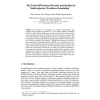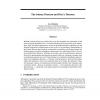12 search results - page 2 / 3 » Implicit fitness and heterogeneous preferences in the geneti... |
BMCBI
2010
12 years 11 months ago
2010
Background: The development, in the last decade, of stochastic heuristics implemented in robust application softwares has made large phylogeny inference a key step in most compara...
EVOW
2006
Springer
13 years 8 months ago
2006
Springer
In this paper we investigate and compare multi-objective and weighted single objective approaches to a real world workforce scheduling problem. For this difficult problem we consid...
JEI
2008
13 years 4 months ago
2008
Skin detection is a preliminary step in many applications. We analyze some of the most frequently cited binary skin classifiers based on explicit color cluster definition and prese...
FOGA
1994
13 years 6 months ago
1994
Holland's Schema Theorem is widely taken to be the foundation for explanations of the power of genetic algorithms (GAs). Yet some dissent has been expressed as to its implica...
ISCI
2007
13 years 4 months ago
2007
As a follow-up to the work of [4] and [5], this paper continues to explore the relationship between wealth share dynamics and risk preferences in the context of an agent-based mul...


